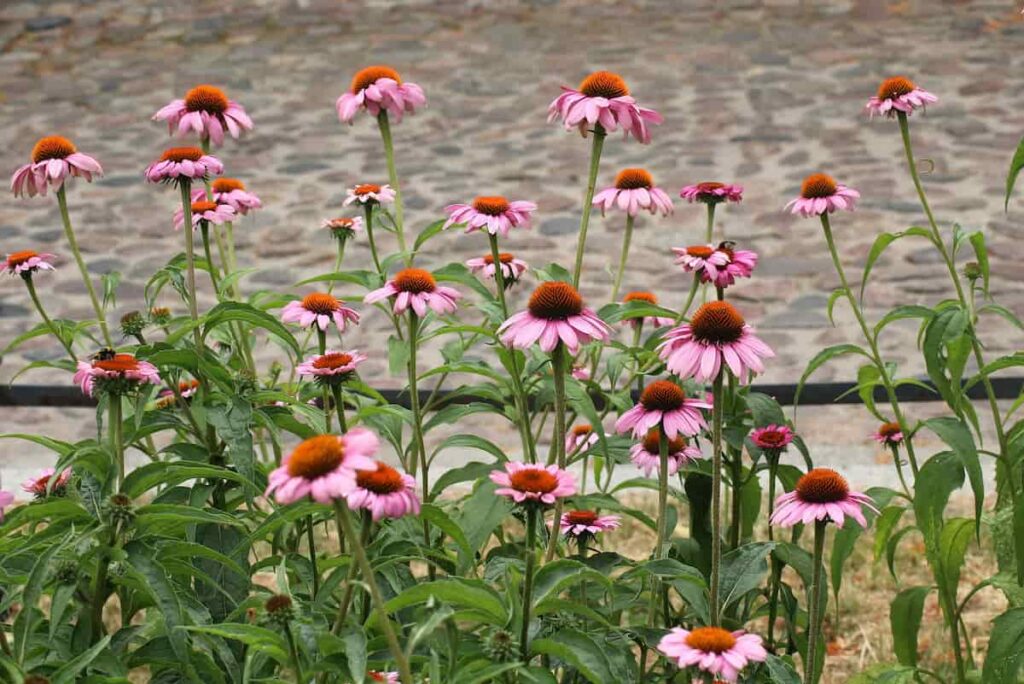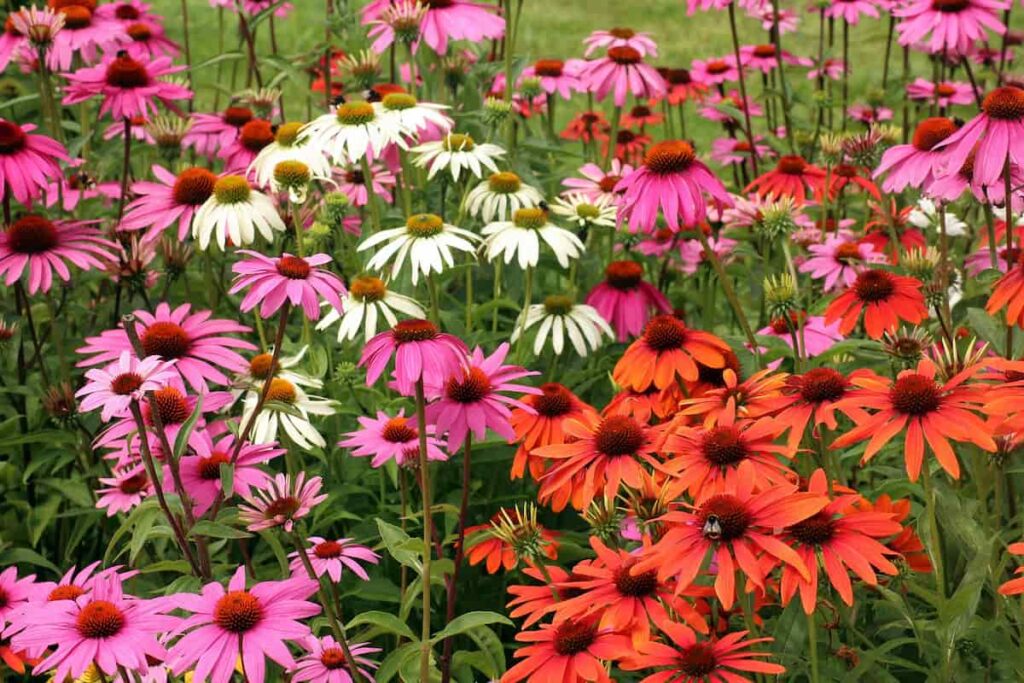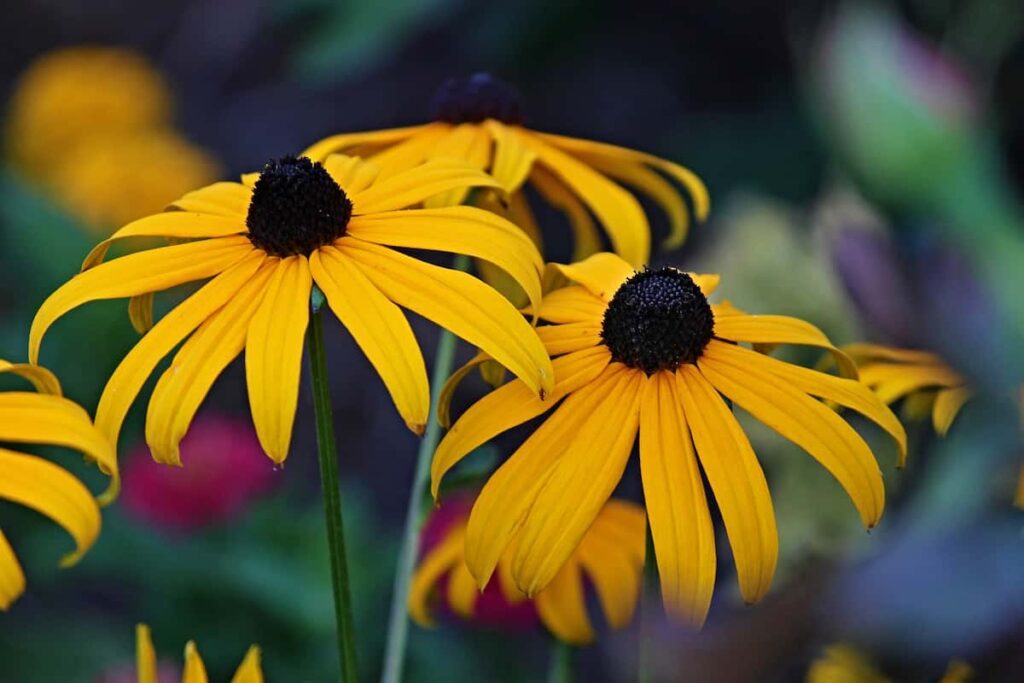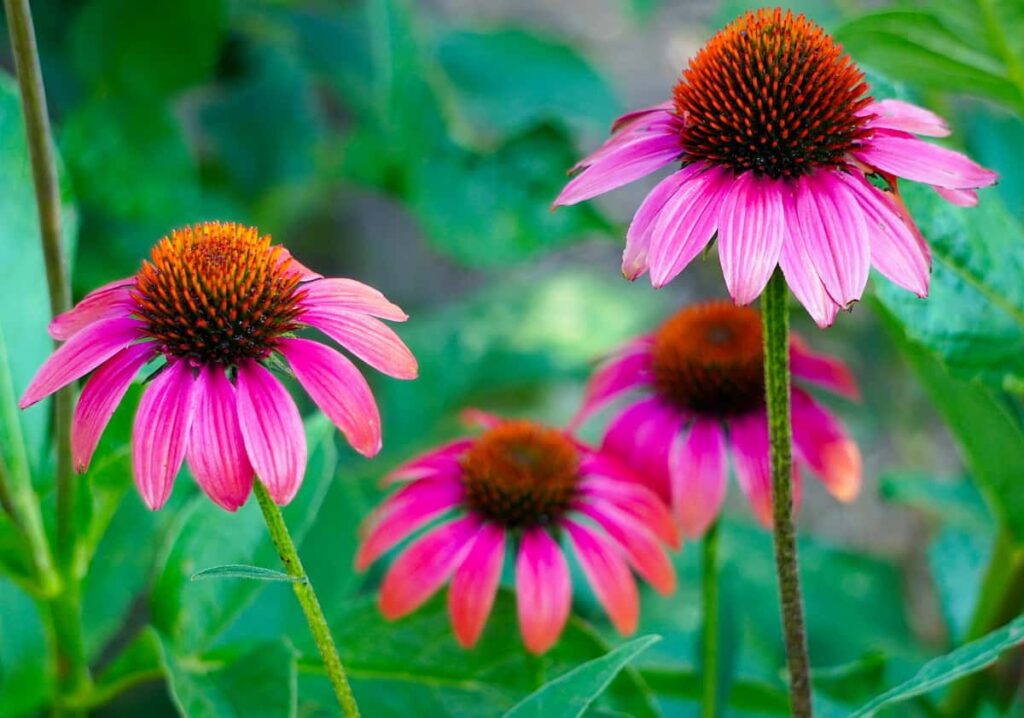Coneflowers are members of the Daisy family. There are many species of Coneflower, and they come in various colors, including pink, purple, white, and yellow. Coneflowers are tolerant of a wide range of soil types and conditions, which makes them easy to grow in most gardens. While Coneflowers don’t require much care, you can do a few things to ensure healthy plants and abundant blooms.

With their bright colors and long blooming season, they’ll add a splash of color to your garden from early summer through fall. They’re also drought-tolerant and attract butterflies, making them a great addition to any garden.
How to grow Coneflowers in your backyard
Coneflower varieties to grow in your backyard
When choosing the right Coneflower for your backyard, remember a few things. The first is what color you want your flowers to be. Coneflowers come in various colors, including white, pink, purple, and yellow. The second is what size you want your plants to be. Coneflowers can range from 2 to 6 feet tall.
- Echinacea Magnus – This variety grows 4 feet tall and has large purple flowers with orange centers.
- Echinacea Prairie Splendor – This variety grows 3 feet tall and has white flowers with green centers.
- Echinacea Ruby Star – This variety grows up to 2 feet tall and has deep pink flowers with yellow centers.
- Echinacea pallida – This variety grows to 3 to 4 feet. The flowers are pale pink or lavender in color and have a greenish-yellow center.
- Echinacea Angustifolia – It grows to a height of 2 to 3 feet and has white or pale pink flowers with a greenish-yellow center.
Climate suitable for growing Coneflowers in your backyard
Coneflowers are a beautiful and easy-to-grow addition to any backyard garden. But before you start planting, you must know a little about their climate needs. Coneflowers prefer a temperate climate with cool summers and mild winters. Coneflower plants grow well in an area that gets at least six hours daily and has well-drained soil.
If you live in hot summers, you can still grow Coneflowers, but you’ll need extra care to ensure they don’t get too stressed. You can also try growing them in containers to move them around to find the perfect spot. With some planning, you can quickly grow Coneflowers in your backyard, no matter your climate.
Soil requirement for growing Coneflowers in your backyard
Coneflowers thrive in many different types of soil as long as the soil is well-drained. They tolerate dry and wet conditions but prefer a sunny spot with moist soils. If you have heavy clay soils, adding organic matter such as compost or peat moss will help improve drainage. Coneflowers also do well in sandy soils.
In case you missed it: How to Choose the Right Soil Testing Meter for Your Garden: Best 20 Soil Testing Meters/Kits in India

If your soil is sandy, you may need to water more frequently to keep the plants from drying. They are adaptable to sandy and clay soils but prefer a loamy mix. If the soil is heavy, add sand or organic matter to help with drainage. Coneflowers can tolerate drought once established but perform best with regular watering, especially during prolonged dry periods.
Water requirement for growing Coneflowers in your backyard
Coneflowers are a beautiful and easy-to-grow flower that adds color and life to any garden. They are drought-tolerant and require little maintenance, making them an excellent choice for those who want to enjoy colorful flowers without much work. Coneflowers can thrive for years with little care when grown in the right conditions.
Coneflowers are drought tolerant, so they don’t need much water. However, too much water can be harmful to Coneflowers. Water your Coneflowers when the soil is dry to the touch. You should water about once a week or as needed. Water newly planted Coneflowers every few days until they become established, then water them every week during the growing season. Make sure the soil around your plants stays moist but not soggy.
When to plant Coneflower seeds?
Coneflowers are one of the best flowers to plant in your backyard. They are beautiful, easy to grow, and require very little maintenance. Spring is the best time to plant Coneflowers after the last frost. You must prepare the soil before planting by tilling it and adding some compost or manure. Once the soil is ready, you can plant your Coneflowers. With some care, your Coneflowers will thrive and provide you with beautiful blooms all summer.
In case you missed it: Growing Morning Glory Flowers: How to Plant and Care

Coneflower propagation
From seed
Coneflowers are a beautiful addition to any backyard and are relatively easy to grow from seed. Start by collecting some Coneflower seeds. You can do this by allowing some of your existing plants to go to seed or purchasing them from a gardening store. Once you harvest the Coneflower seeds, it’s time to start germinating. To stratify, mix the seeds with moist sand and place them in a zip-top baggie in the refrigerator. After four weeks, plant them in starter pots filled with potting soil.
Be sure to plant them shallowly, only about 1/4 inch deep, as they need light to germinate. You should keep the pots in a sunny location. You should see little sprouts emerging from the soil within a few weeks. Once the sprouts are an inch or two tall, transplant them into individual pots or your garden beds outside. You should give plenty of room to grow. Coneflowers can get quite large. During the growing season, water regularly and fertilize monthly. Deadhead spent flowers regularly.
From cuttings
Coneflowers are easy to propagate from cuttings. You should take cuttings in late summer when the plants are actively growing. Take 4–6-inch stem cuttings from the tips of the plants. Strip off the lower leaves, leaving 2-3 leaves on the cutting. Dip the end of the Coneflower cutting in rooting hormone and plant in a well-drained potting mix. Water well and place in a bright, sunny location. You should maintain the soil moist but not wet, and in 6-8 weeks, your Coneflower cuttings should be rooted and ready to transplant into your garden.
In case you missed it: 14 Self-Seeding Flowers: Why They are Great for Your Backyard Garden

Transplanting Coneflower seedlings
When it’s time to transplant your Coneflower seedlings, choose a spot in your backyard that gets plenty of sunlight. You’ll also want to make sure the soil is well-draining. If the soil is too heavy, the roots won’t get the oxygen they need, and the plant will suffocate. Before you transplant, water the seedlings well, so their roots are nice and moist.
Gently loosen the soil around each plant before carefully lifting it out of its pot. Place the plant in the prepared hole, ensuring the roots are spread out evenly. Once all the plants are transplanted, water them again and give them a good dose of fertilizer. With care, your Coneflowers will soon take root in their new home and begin to thrive.
Coneflower care
Fertilizer requirement for growing Coneflowers in your backyard
When deciding when to fertilize your Coneflowers, there are a few things to consider. The type of fertilizer you use, the age of your plants, and the time of year are all essential factors. If you’re using a granular fertilizer, applying it in the spring or fall is best. If you’re using a liquid fertilizer, you can apply it throughout the growing season. The age of your plants is also an important consideration.
Newer plants will need more frequent fertilization than established plants. Once your plants are established, you can reduce the frequency with which you fertilize them. Finally, consider the time of year when deciding when to fertilize your Coneflowers. You can fertilize throughout the year if you live in an area with a long growing season.
If you live in a shorter growing season area, it’s best to fertilize in the spring so that your plants have plenty of time to grow before winter arrives. Coneflowers are heavy feeders and will benefit from being fertilized every 4-6 weeks during the growing season. Over-fertilizing can be harmful to your plant, so don’t overdo it.
In case you missed it: 16 Best Outdoor Flowering Plants in India: How to Plant, Grow and Care

Pruning for Coneflower plants
Pruning for Coneflowers is a bit different than for other plants. You’ll want to wait until the plant is blooming before you prune it back. This will ensure the plant has time to store energy for the next season. You can cut the Coneflower stems back about 6 inches above the ground. This will encourage new growth and help the plant stay healthy.
Prune in early spring before new growth begins. This will help prevent damage to the new shoots. Cut back the previous year’s growth by about one-third. This will encourage fresh, new growth. Remove any dead or dying flowers and leaves. This will keep your plant healthy and promote new growth. Be careful not to damage the crown of the plant when pruning. The crown is where the new shoots emerge, so avoid it when trimming back the plant.
Deadheading for Coneflower
To keep your Coneflowers looking their best, you must deadhead them regularly. Deadheading not only helps the plant to look nicer, but it also helps to encourage more blooms. To deadhead a Coneflower, snip off the flower head at the base of the stem. Be sure to dispose of the spent flower heads in the trash, so they don’t attract pests or diseases back to your plant.
Pest and diseases of Coneflowers and their control
When growing Coneflowers, pests and diseases are common problems. Aphids, Japanese beetles, and caterpillars are all common pests that can damage the leaves and flowers of your plants. Diseases like powdery mildew, black spot, and rust can also affect Coneflowers. Fortunately, there are many ways to control pests and diseases on Coneflowers. Chemical pesticides can be effective but can harm beneficial insects and other wildlife. Organic control methods, such as companion planting and homemade remedies, are often safer and more effective.
- Aphids – Aphids can be controlled by spraying plants with water or using insecticidal soap.
- Japanese beetles – Japanese beetles can be trapped using a special trap or handpicked from the plants and dropped into a bucket of soapy water.
- Caterpillars – Caterpillars can be controlled by spraying plants with Bacillus thuringiensis, a safe biological pesticide for humans and animals.
- Powdery mildew – To prevent powdery mildew from forming, ensure to water your plant at the base instead of above. You can also use a fungicide to treat powdery mildew if it does form.
- Black spot – Black spot is another fungal disease that can cause severe damage to your plant. This disease forms black spots on the plant leaves, eventually leading to leaf loss. Ensure adequate air circulation around your plant to prevent the black spot from forming. You can also use a fungicide to treat the black spot if it does form.
- Rust – Rust is a fungal disease that causes orange or red pustules on the plant’s leaves. To prevent rust from forming, ensure adequate air circulation around your plant. You can also use a fungicide to treat rust if it does form.
In case you missed it: How to Grow Flowers in Winter in India: Planting, and Care

Harvesting of Coneflower
Coneflowers are a fantastic addition to any garden and are easy to grow. Cut the flower heads off at the stem, careful not to damage the leaves. You should place the Coneflower heads in a paper bag or vase and then in a cool, dark place. Allow the flowers to dry for about two weeks. Once they’re dry, remove the petals from the flower heads and store them in an airtight container.
Conclusion
Growing Coneflowers in your backyard is a great way to add color and beauty to your landscape. Coneflowers are easy to grow and require little maintenance, making them perfect for even the novice gardener. With their vibrant blooms and long flowering season, they’ll soon become one of your favorite flowers. With just a little care, you can have a healthy and thriving Coneflower plant that will add color and life to your space.
- Broccoli Seed Germination and Selection
- Asparagus Seed Germination and Variety Selection
- Seasonal Flower Gardening: Best Practices for Spring, Summer, Fall, and Winter
- How to Grow Hibiscus from Flower
- Plantation Ideas for Home Decoration: A Beginners Guide
- Flower Garden Designs and Layouts for Beginners
- Planting and Spacing Techniques in Papaya: A Beginner’s Guide
- Growing Gold: Essential Techniques for Planting Pineapples
- How to Make Kalanchoe Plant Bushy: Home Remedies and Solutions
- 11 Reasons Why Your Gardenia is Not Blooming: Home Remedies and Solutions
- Eco Elegance: The Guide to Designing a Drought-Tolerant Landscape
- Gardening on a Slope: Strategies for Hillside Landscaping
- Nourish and Flourish: Top Organic Mulches for Thriving House Plants
- Everything You Want to Know about Indian Mogra Flower: Discover Uses and Growing
- Green Thumb Success: Expert Tips for Cultivating Greenhouse Pumpkins All Year Round
- Maximize Growth & Flavor: The Ultimate Guide to Companion Planting in Herb Gardens
- How to Control Rhododendron Problems Naturally: Home Remedies and Organic Ways to Fix Them
- Natural Magic: The Remarkable Benefits of Cinnamon for Plants
- Best Steps to Revive Dying Tulip with Natural and Organic Treatment
- 10 Reasons Why Your Angel Trumpet is Not Blooming: Remedies and Treatment
- How to Fix Periwinkle Leaf and Flower-Related Problems: Natural Remedies and Solutions
- How to Fix Zinnias Leaf and Flower Problems: Discover Natural and Home Remedies
- Organic Steps to Induce Lemon Tree Flowers: A Comprehensive Guide
- Bloom Booster: Crafting the Perfect Homemade Bougainvillea Fertilizer
- Optimizing Growth: A Guide to Applying NPK Fertilizer for Potted Plants
- 10 Best Homemade Fertilizers for Rubber Plant: DIY Recipes and Application Method
- How to Boost Female Pumpkin Flowers: Effective Steps for More Flowers and High Yields
- Transform Your Indoor Garden: Top Benefits of Pink Salt for Houseplants
- 10 Best Homemade Fertilizers for Peacock Plants (Calathea): Easy DIY Guide
- Unlock Blooms: 9 Reasons Why Your Potted Chrysanthemum is Not Blooming
- 8 Reasons Why Your Potted Hibiscus is Not Blooming: Fix it with Simple Solutions
- Unlock Blooms: 9 Key Reasons Your Potted Frangipani Won’t Flower
- 10 Reasons Why Is My Ice Plant Not Blooming: Remedies and Treatment
- 10 Reasons Why My Potted Hydrangea Not Blooming: Treatment and Remedies
- 10 Reasons Why is My Wisteria Not Blooming: Remedies and Treatment
- 10 Reasons Why is My Goldfish Plant Not Blooming: Remedies and Treatment